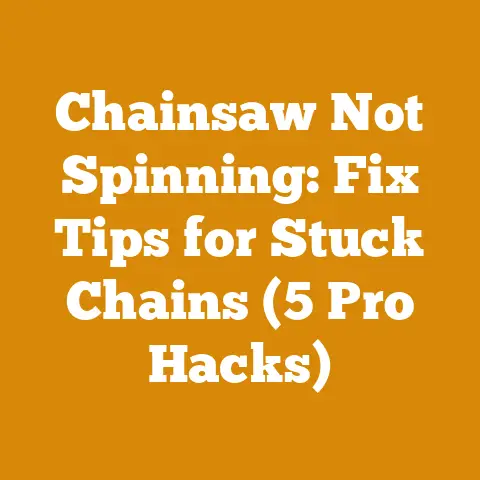Manual Tree Pruner Guide (5 Essential Tips for Precision Cuts)
The crisp scent of freshly cut wood, a symphony of birdsong overhead, and the satisfying snip of a branch giving way under the pressure of a well-aimed pruner. That’s the feeling I chase every time I step into my little patch of woodland. There’s something deeply satisfying about shaping a tree, guiding its growth, and knowing you’re contributing to its health and longevity. But precision pruning isn’t just about aesthetics; it’s about the long-term well-being of your trees.
I’ve spent years honing my skills with manual tree pruners, learning from both my successes and my mistakes (and believe me, there have been plenty of both!). In this guide, I’m going to share my essential tips for achieving precision cuts, ensuring your trees thrive for years to come.
Key Takeaways:
- Sharpness is Paramount: A dull pruner is a recipe for disaster. Learn how to sharpen your blades for clean, efficient cuts.
- Understanding Branch Anatomy: Knowing where to cut is just as important as how to cut. We’ll delve into the anatomy of a branch and the “branch collar.”
- The Three-Cut Method: Prevent bark tearing and ensure a clean, healthy wound with this essential technique.
- Choosing the Right Pruner: Not all pruners are created equal. I’ll help you select the best tool for the job, considering tree size and branch diameter.
- Post-Pruning Care: Proper wound care can significantly impact a tree’s recovery and resistance to disease.
Let’s get started!
Manual Tree Pruner Guide: 5 Essential Tips for Precision Cuts
The Importance of Precision Pruning
Before we dive into the nitty-gritty, let’s understand why precision pruning is so crucial. It’s not just about making your trees look pretty (though that’s a nice bonus!). Precision pruning directly impacts:
- Tree Health: Removing dead, diseased, or crossing branches promotes airflow and sunlight penetration, reducing the risk of fungal infections and pest infestations.
- Structural Integrity: Pruning can strengthen a tree’s structure, making it more resistant to wind and snow damage.
- Fruit Production: For fruit trees, pruning is essential for maximizing yield and improving fruit quality. A study by the University of California, Davis, found that proper pruning can increase fruit production by up to 30% in some varieties.
- Aesthetics: A well-pruned tree is simply more visually appealing, enhancing the overall landscape.
- Safety: Removing hazardous branches that could fall and cause injury or property damage is a critical safety measure.
I remember one year, neglecting to prune a young apple tree properly. The result? Overcrowded branches, poor fruit development, and a nasty case of apple scab. That was a lesson learned the hard way, and it cemented my commitment to precision pruning.
Tip #1: Sharpen Your Pruners – A Sharp Blade is a Happy Blade
A dull pruner is your enemy. It crushes and tears branches instead of making clean cuts, leaving ragged wounds that are susceptible to disease and insect infestation. Think of it like using a butter knife to cut a tomato – messy and inefficient. A sharp pruner, on the other hand, slices through branches with ease, minimizing damage and promoting rapid healing.
Why Sharpness Matters (Data-Backed):
- Reduced Healing Time: Research from the International Society of Arboriculture (ISA) shows that clean, sharp cuts heal up to 50% faster than ragged, dull cuts.
- Lower Disease Risk: Sharp cuts minimize the surface area exposed to pathogens, reducing the risk of infection.
- Less Effort: Sharp pruners require less force, reducing fatigue and strain on your hands and wrists.
- Improved Cut Accuracy: A sharp blade allows for more precise cuts, minimizing damage to surrounding tissue.
How to Sharpen Your Pruners:
I’ve experimented with various sharpening methods over the years, and here’s my preferred approach:
- Gather Your Supplies: You’ll need a sharpening stone (I prefer a dual-grit stone with a coarse side for removing nicks and a fine side for honing), lubricating oil (like honing oil or even mineral oil), and a clean cloth.
- Clean Your Pruners: Remove any dirt, sap, or rust from the blades with a wire brush and a solvent like turpentine.
- Identify the Bevel: The bevel is the angled surface on the cutting blade. You’ll want to focus your sharpening efforts on this area.
- Lubricate the Stone: Apply a few drops of lubricating oil to the sharpening stone. This helps the stone glide smoothly and prevents metal buildup.
- Sharpen the Bevel: Hold the pruner blade at the same angle as the bevel and draw it across the coarse side of the sharpening stone in a smooth, sweeping motion. Apply consistent pressure. Repeat this process several times, working from the base of the blade to the tip.
- Hone the Edge: Switch to the fine side of the sharpening stone and repeat the process, using lighter pressure. This will refine the edge and create a razor-sharp finish.
- Remove the Burr: After sharpening, you may notice a small burr (a thin, raised edge) on the back of the blade. Remove this by gently drawing the back of the blade across the sharpening stone at a very slight angle.
- Test the Sharpness: Carefully test the sharpness of the blade by slicing through a piece of paper or cardboard. The blade should cut cleanly and easily.
- Clean and Lubricate: Wipe the blade clean with a cloth and apply a light coat of lubricating oil to prevent rust.
Pro Tip: Invest in a good-quality sharpening stone. A cheap stone will wear down quickly and won’t provide a consistent sharpening surface. I’ve found that diamond sharpening stones offer excellent performance and longevity.
Frequency: How often should you sharpen your pruners? It depends on how often you use them and the type of wood you’re cutting. As a general rule, I sharpen mine after every few hours of use, or whenever I notice the blades starting to dull.
Tip #2: Understanding Branch Anatomy – Know Where to Cut
Knowing where to cut is just as crucial as knowing how to cut. Cutting in the wrong place can damage the tree and hinder its ability to heal. The key is to understand the anatomy of a branch and the importance of the “branch collar.”
The Branch Collar: Your Guiding Light
The branch collar is the swollen area at the base of the branch where it joins the trunk. It’s formed by the overlapping tissues of the branch and the trunk. This area is rich in cells that are essential for wound closure and disease resistance.
Why the Branch Collar Matters:
- Natural Wound Closure: The branch collar contains cells that readily form callus tissue, which seals the wound and prevents decay.
- Disease Resistance: The tissues in the branch collar are more resistant to fungal and bacterial infections.
- Proper Compartmentalization: When a branch is properly pruned at the branch collar, the tree can effectively compartmentalize the wound, preventing the spread of decay into the trunk.
The Wrong Way to Cut (and Why):
- Flush Cuts: Cutting flush with the trunk removes the branch collar, damaging the trunk tissue and hindering the tree’s ability to heal. This leaves a large, open wound that is highly susceptible to decay.
- Leaving Stubs: Leaving a stub of branch tissue beyond the branch collar provides a breeding ground for insects and diseases. The stub will eventually die and decay, potentially spreading infection into the trunk.
The Right Way to Cut:
- Locate the Branch Collar: Identify the swollen area at the base of the branch.
- Cut Just Outside the Branch Collar: Make your cut just outside the branch collar, at a slight angle. Avoid cutting into the collar itself, but don’t leave a stub.
Visual Aid: Imagine the branch collar as a slightly raised ring around the base of the branch. You want to cut just outside this ring, leaving a clean, smooth surface.
Expert Insight: “Think of the branch collar as the tree’s natural bandage,” says Dr. Alex Shigo, a renowned expert in tree biology. “Cutting outside the collar allows the tree to seal the wound properly and protect itself from infection.”
Tip #3: The Three-Cut Method – Prevent Bark Tearing
The three-cut method is an essential technique for removing larger branches without tearing the bark and damaging the trunk. Bark tearing can create significant wounds that are slow to heal and highly susceptible to disease.
Why the Three-Cut Method is Crucial:
- Prevents Bark Tearing: The weight of a large branch can cause the bark to tear as it falls, especially if you’re cutting from above. The three-cut method supports the branch and prevents this from happening.
- Minimizes Wound Size: By preventing bark tearing, the three-cut method ensures a smaller, cleaner wound that heals more quickly.
- Protects the Trunk: Bark tearing can damage the underlying trunk tissue, weakening the tree and making it more vulnerable to pests and diseases.
The Three Steps (Illustrated):
- Undercut: Make an undercut on the underside of the branch, about 12-18 inches from the trunk. Cut about one-third of the way through the branch. This cut will prevent the bark from tearing upwards when you make the next cut.
- Top Cut: Make a top cut about 2-4 inches further out from the undercut. Cut completely through the branch. The branch will now fall away, leaving a stub.
- Final Cut: Now, carefully cut the remaining stub just outside the branch collar, as described in Tip #2. This is the most important cut, so take your time and ensure you’re cutting in the right place.
Visual Aid: Imagine you’re creating a “hinge” with the undercut. The top cut allows the branch to break away at the hinge, preventing the bark from tearing.
Personal Anecdote: I once tried to remove a large branch from an oak tree without using the three-cut method. Predictably, the bark tore away, leaving a gaping wound that took years to heal. That experience taught me the value of patience and proper technique.
Safety First: Always wear appropriate safety gear when pruning, including safety glasses, gloves, and a hard hat. Be aware of your surroundings and ensure there are no people or objects in the path of the falling branch.
Tip #4: Choosing the Right Pruner – Match the Tool to the Task
Not all pruners are created equal. Choosing the right pruner for the job is essential for efficiency, precision, and safety. There are several types of manual tree pruners available, each designed for specific tasks and branch sizes.
Types of Manual Tree Pruners:
- Hand Pruners (Secateurs): These are the most common type of pruner, ideal for cutting small branches up to about ¾ inch in diameter. There are two main types of hand pruners:
- Bypass Pruners: These pruners have two blades that pass each other like scissors, creating a clean, precise cut. They are best for live, green wood.
- Anvil Pruners: These pruners have a single blade that closes against a flat anvil. They are better for cutting dead or dry wood, as they tend to crush live wood.
- Loppers: Loppers are essentially long-handled hand pruners, designed for cutting branches up to about 2 inches in diameter. The longer handles provide more leverage, making it easier to cut thicker branches.
- Pole Pruners: Pole pruners have a cutting head attached to a long pole, allowing you to reach high branches without using a ladder. They are available in both manual and powered versions.
Factors to Consider When Choosing a Pruner:
- Branch Diameter: Choose a pruner that is appropriate for the size of the branches you’ll be cutting. Trying to cut a branch that is too thick for your pruner can damage the tool and injure yourself.
- Tree Type: Different tree types have different wood densities. Hardwoods like oak and maple require more powerful pruners than softwoods like pine and fir.
- Ergonomics: Choose a pruner that is comfortable to use and fits well in your hand. Look for features like cushioned grips and lightweight materials.
- Durability: Invest in a high-quality pruner that is made from durable materials and designed to last. A well-made pruner will save you money in the long run.
My Personal Recommendations:
- For general pruning of small branches: I swear by my Felco F-8 bypass pruners. They are incredibly sharp, durable, and comfortable to use.
- For thicker branches: I use a Fiskars PowerGear2 lopper. The gear mechanism provides extra leverage, making it easy to cut through branches up to 2 inches in diameter.
- For high branches: I have a Jameson fiberglass pole pruner. It’s lightweight and sturdy, allowing me to reach branches up to 12 feet high.
Data Point: A study by Oregon State University found that using the correct type of pruner for the job can increase pruning efficiency by up to 25%.
Pro Tip: Don’t be afraid to spend a little extra money on a good-quality pruner. A well-made pruner will last for years and provide superior performance compared to a cheaper model.
Tip #5: Post-Pruning Care – Help Your Tree Heal
Once you’ve made your cuts, it’s important to provide proper post-pruning care to help your tree heal and prevent disease. While the old adage of painting every cut with tree sealant is now considered outdated, there are still steps you can take to promote healthy wound closure.
Why Post-Pruning Care Matters:
- Accelerates Healing: Proper care can speed up the healing process, reducing the risk of infection.
- Prevents Disease: Post-pruning care can help protect the wound from fungal and bacterial pathogens.
- Minimizes Stress: Pruning can be stressful for trees. Post-pruning care can help them recover and thrive.
Steps for Post-Pruning Care:
- Clean the Wound: Remove any loose bark or debris from around the wound with a clean brush.
- Avoid Tree Sealants (Generally): In most cases, tree sealants are not necessary and can actually hinder the healing process. They can trap moisture and create a breeding ground for pathogens. However, there are exceptions:
- Specific Diseases: In cases where a tree is known to be susceptible to a specific disease, such as oak wilt, a tree sealant may be recommended to prevent infection. Consult with a certified arborist for guidance.
- Cosmetic Reasons: In some cases, tree sealants may be used for cosmetic reasons, to improve the appearance of the wound. However, this is generally not recommended.
- Water and Fertilize: Provide your tree with adequate water and fertilizer to support its recovery. A balanced fertilizer with a slow-release formula is ideal.
- Monitor the Wound: Keep an eye on the wound for any signs of infection, such as discoloration, oozing, or unusual growth. If you notice any problems, consult with a certified arborist.
- Mulch Around the Base: Apply a layer of mulch around the base of the tree to help retain moisture and suppress weeds. Keep the mulch a few inches away from the trunk to prevent rot.
Expert Opinion: “Healthy trees are best equipped to heal themselves,” says Linda Chalker-Scott, a professor of horticulture at Washington State University. “Focus on providing your trees with optimal growing conditions, and they will be able to compartmentalize pruning wounds effectively.”
Case Study: A study by the University of Florida found that trees that were properly watered and fertilized after pruning healed significantly faster than trees that were not.
A Note on Tree Sealants: While the current consensus is that tree sealants are generally not necessary, there are some situations where they may be beneficial. For example, if you are pruning a tree that is known to be susceptible to a specific disease, a tree sealant may help to prevent infection. Always consult with a certified arborist before applying a tree sealant.
Beyond the Basics: Advanced Pruning Techniques
Once you’ve mastered the basics of precision pruning, you can explore some more advanced techniques to further enhance the health and appearance of your trees.
Crown Thinning:
Crown thinning involves selectively removing branches from the crown of the tree to improve airflow and sunlight penetration. This can help to reduce the risk of disease and improve fruit production.
Crown Raising:
Crown raising involves removing lower branches to increase clearance beneath the tree. This is often done to improve visibility or to allow for pedestrian or vehicular traffic.
Crown Reduction:
Crown reduction involves reducing the overall size of the tree by selectively shortening branches. This is often done to reduce the risk of wind damage or to improve the tree’s appearance.
Espalier:
Espalier is a technique of training trees to grow in a flat plane, typically against a wall or fence. This is often done for ornamental purposes or to maximize fruit production in a small space.
Pollarding:
Pollarding is a technique of pruning trees at a specific height to encourage dense growth of new shoots. This is often done for aesthetic reasons or to control the size of the tree.
Coppicing:
Coppicing is a technique of cutting trees to ground level to encourage the growth of multiple stems. This is often done for fuelwood production or to create wildlife habitat.
These advanced techniques require a deeper understanding of tree physiology and pruning principles. I highly recommend consulting with a certified arborist before attempting any of these techniques on your own.
The Future of Pruning: Technology and Innovation
The world of pruning is constantly evolving, with new technologies and innovations emerging all the time. Here are a few trends to watch:
- Electric Pruners: Electric pruners are becoming increasingly popular, offering greater power and efficiency compared to manual pruners. They are especially useful for large-scale pruning projects.
- Robotic Pruners: Robotic pruners are still in their early stages of development, but they have the potential to revolutionize the industry. These robots can autonomously prune trees, reducing labor costs and improving efficiency.
- Drones for Tree Inspection: Drones equipped with high-resolution cameras can be used to inspect trees for signs of disease or damage. This allows arborists to identify problems early and take preventative measures.
- AI-Powered Pruning: Artificial intelligence (AI) is being used to develop pruning algorithms that can optimize tree health and productivity. These algorithms can analyze tree structure and growth patterns to determine the best pruning strategy.
While these technologies are exciting, it’s important to remember that the fundamental principles of precision pruning remain the same. A sharp blade, a knowledge of tree anatomy, and a commitment to proper technique are still essential for achieving optimal results.
Conclusion: Your Journey to Precision Pruning
Precision pruning is a skill that takes time and practice to master. Don’t be discouraged if you make mistakes along the way. Every cut is a learning opportunity. By following the tips in this guide and continuing to learn and experiment, you can become a skilled pruner and help your trees thrive for years to come.
Actionable Next Steps:
- Sharpen your pruners: Take some time to sharpen your pruners using the method described in Tip #1.
- Identify a tree to prune: Choose a tree in your yard or garden that needs pruning.
- Assess the tree: Examine the tree carefully and identify any dead, diseased, or crossing branches.
- Plan your cuts: Before you start pruning, plan your cuts carefully, taking into account the branch collar and the three-cut method.
- Prune the tree: Prune the tree using the techniques described in this guide.
- Monitor the tree: Keep an eye on the tree for any signs of infection or stress.
Remember, precision pruning is not just about making your trees look pretty; it’s about promoting their health, longevity, and overall well-being. So grab your pruners, put on your safety gear, and get out there and start pruning! And don’t forget to enjoy the crisp scent of freshly cut wood and the satisfying snip of a branch giving way under the pressure of a well-aimed pruner. Happy pruning!






